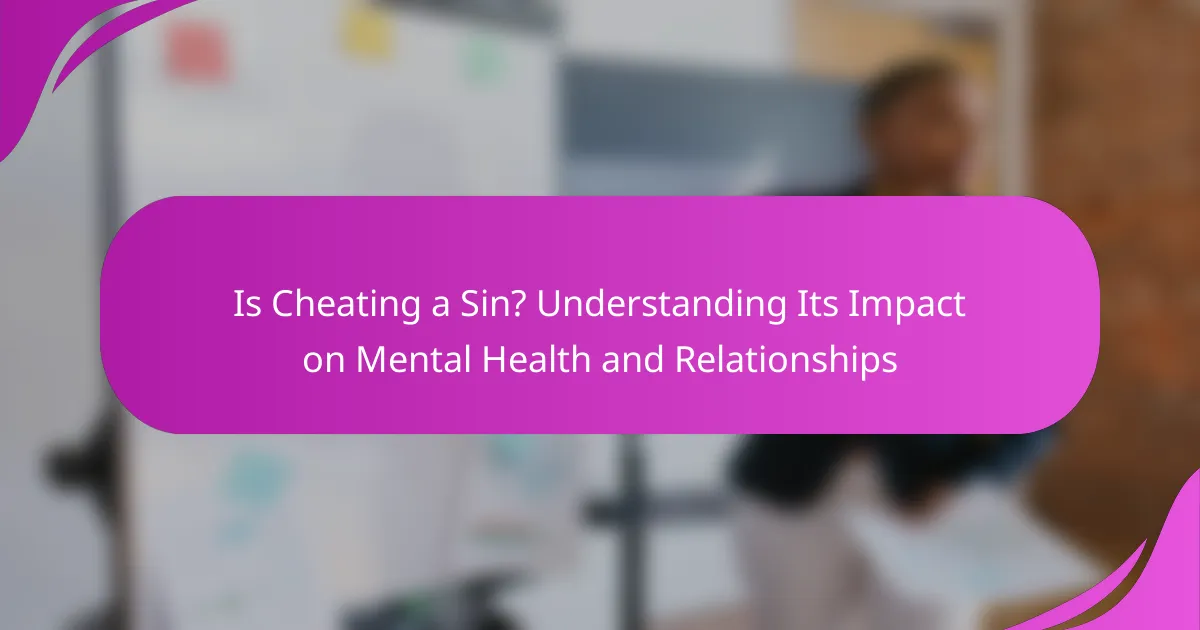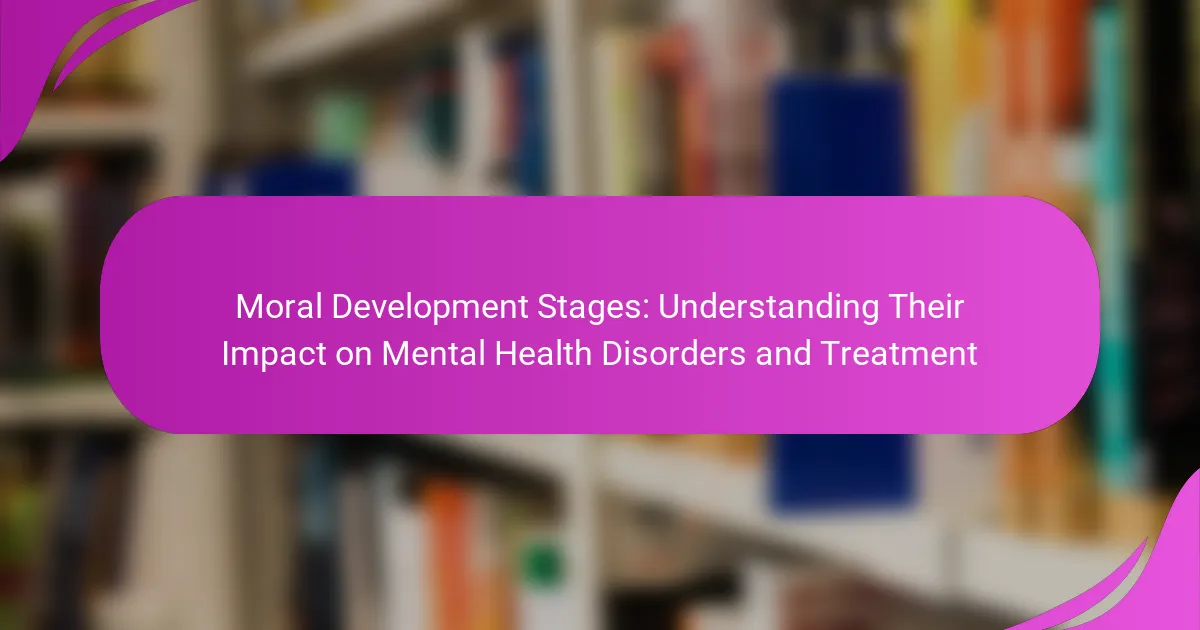Understanding mental health disorders is essential for improving treatment outcomes and reducing stigma. This article explores common and rare disorders, their symptoms, and effective treatment options. It also addresses the challenges individuals face, including stigma and access to care. Finally, it highlights the importance of support and understanding in fostering recovery.
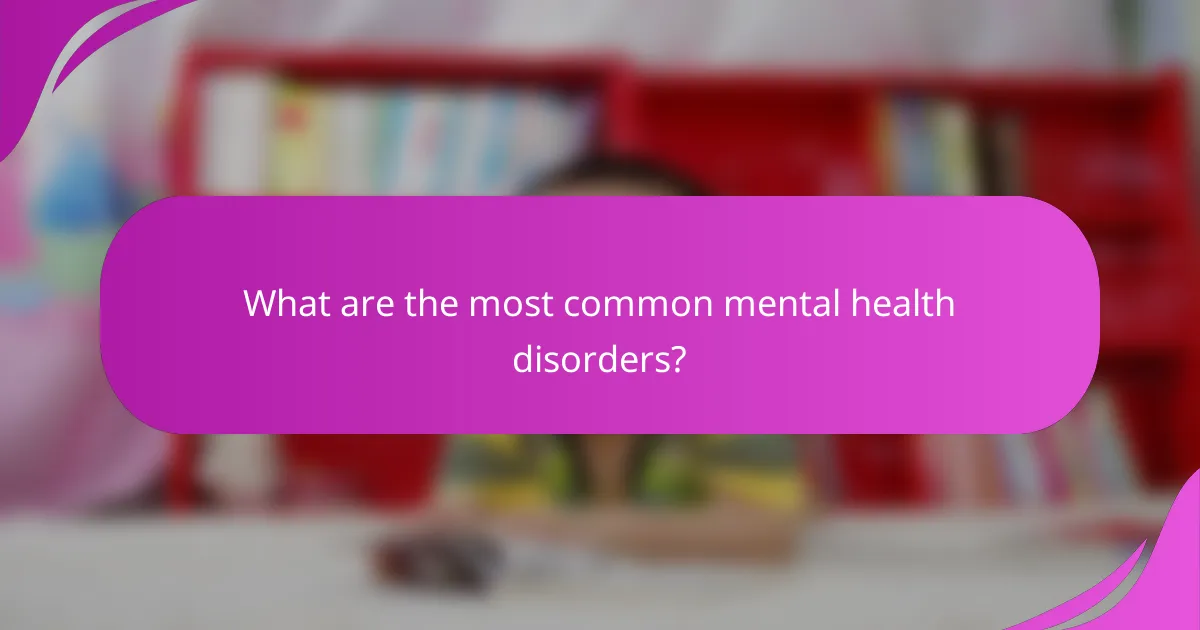
What are the most common mental health disorders?
The most common mental health disorders include anxiety disorders, mood disorders, schizophrenia, and personality disorders. Anxiety disorders affect millions, characterized by excessive fear or worry. Mood disorders, such as depression, impact emotional regulation. Schizophrenia presents unique challenges, including delusions and impaired thinking. Personality disorders involve enduring patterns of behavior that deviate from cultural expectations. Understanding these disorders is crucial for reducing stigma and improving treatment outcomes.
How do anxiety disorders manifest?
Anxiety disorders manifest through a range of symptoms, including excessive worry, restlessness, and physical symptoms like increased heart rate. These disorders can lead to significant impairment in daily functioning. Common manifestations include panic attacks, social anxiety, and generalized anxiety, each presenting unique attributes. For example, panic attacks often involve sudden, intense fear and physical reactions, while social anxiety is characterized by intense fear of social situations. Understanding these manifestations aids in recognizing and addressing anxiety disorders effectively.
What are the symptoms of depression?
Depression symptoms include persistent sadness, loss of interest in activities, fatigue, changes in appetite, and difficulty concentrating. These symptoms can vary in intensity and duration, affecting daily functioning. Commonly, individuals may experience feelings of worthlessness or guilt, sleep disturbances, and thoughts of death or suicide. Recognizing these symptoms is crucial for seeking appropriate treatment.
What defines bipolar disorder?
Bipolar disorder is characterized by extreme mood swings, including emotional highs (mania or hypomania) and lows (depression). The disorder affects daily functioning and can lead to significant distress. Symptoms can vary widely, but common indicators include changes in sleep patterns, energy levels, and activity levels. Treatment often involves a combination of medication and psychotherapy, which can help manage symptoms and improve quality of life. Understanding bipolar disorder is crucial to reduce stigma and support those affected.
How does schizophrenia present itself?
Schizophrenia typically presents with a range of symptoms including delusions, hallucinations, disorganized thinking, and impaired functioning. These symptoms can vary in intensity and duration, impacting daily life significantly.
Delusions often manifest as false beliefs that are resistant to reason, while hallucinations may involve hearing voices or seeing things that aren’t present. Disorganized thinking can lead to incoherent speech and difficulty organizing thoughts. Impaired functioning affects social interactions and the ability to perform daily tasks.
The onset of symptoms usually occurs in late adolescence or early adulthood. Early intervention is crucial for effective management and treatment, which may include medication and therapy. Understanding these symptoms helps reduce stigma and encourages individuals to seek help.
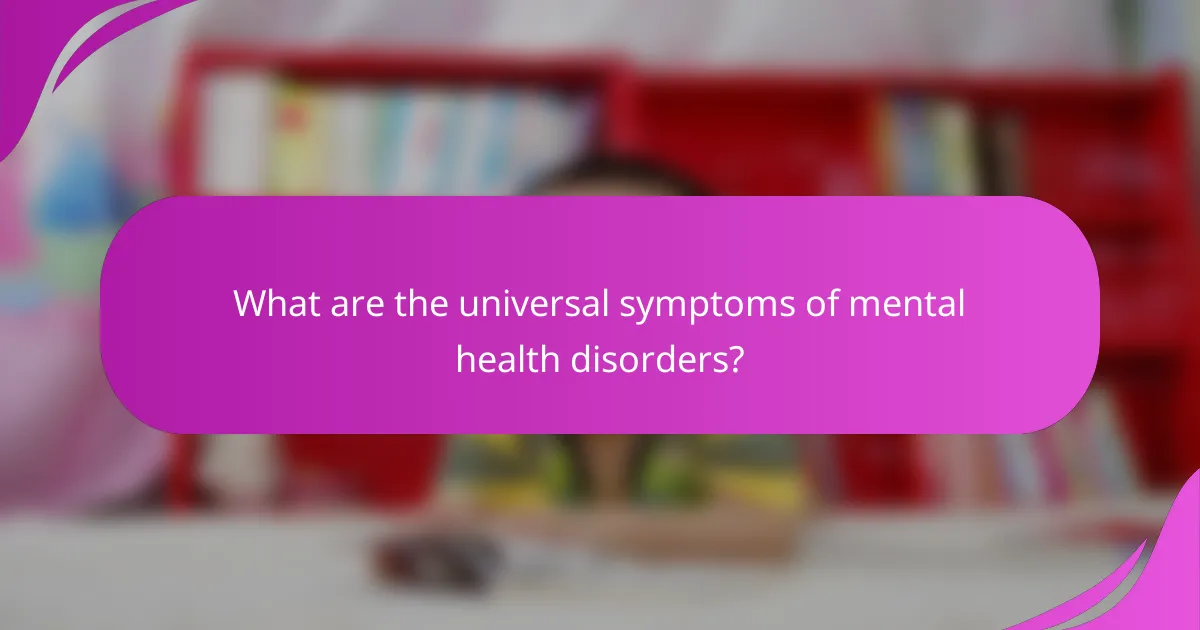
What are the universal symptoms of mental health disorders?
Universal symptoms of mental health disorders include persistent sadness, anxiety, mood swings, and changes in sleep or appetite. These symptoms can vary in intensity and may impact daily functioning. Recognizing these signs is crucial for early intervention and treatment. Common symptoms also encompass withdrawal from social activities, difficulty concentrating, and feelings of hopelessness. Understanding these indicators can help reduce stigma and promote mental health awareness.
How do emotional symptoms vary across disorders?
Emotional symptoms vary significantly across mental health disorders. For example, depression often leads to persistent sadness, while anxiety may manifest as excessive worry.
| Disorder | Common Emotional Symptoms | Unique Attributes |
|——————-|———————————–|————————————-|
| Depression | Sadness, hopelessness | Anhedonia (loss of interest) |
| Anxiety Disorders | Worry, fear | Panic attacks |
| Bipolar Disorder | Mood swings, irritability | Manic episodes |
| Schizophrenia | Emotional flatness, paranoia | Delusions |
| PTSD | Flashbacks, severe anxiety | Emotional numbing |
| OCD | Intrusive thoughts, anxiety | Compulsive behaviors |
Understanding these variations helps in tailoring effective treatments and reducing stigma associated with each disorder.
What physical symptoms are often associated with mental health issues?
Physical symptoms often associated with mental health issues include fatigue, headaches, digestive problems, and sleep disturbances. These symptoms can manifest due to stress, anxiety, or depression. For example, individuals with anxiety may experience increased heart rate and muscle tension. Recognizing these symptoms is crucial for seeking appropriate treatment.
How do cognitive symptoms affect daily life?
Cognitive symptoms can significantly hinder daily life by affecting concentration, memory, and decision-making. Individuals may struggle with tasks that require focus, leading to decreased productivity and increased frustration. Social interactions often suffer as cognitive impairments can cause misunderstandings and difficulty in communication. As a result, the stigma surrounding mental health disorders can exacerbate feelings of isolation and anxiety, impacting overall well-being. Addressing these symptoms through appropriate treatments can help improve daily functioning and quality of life.
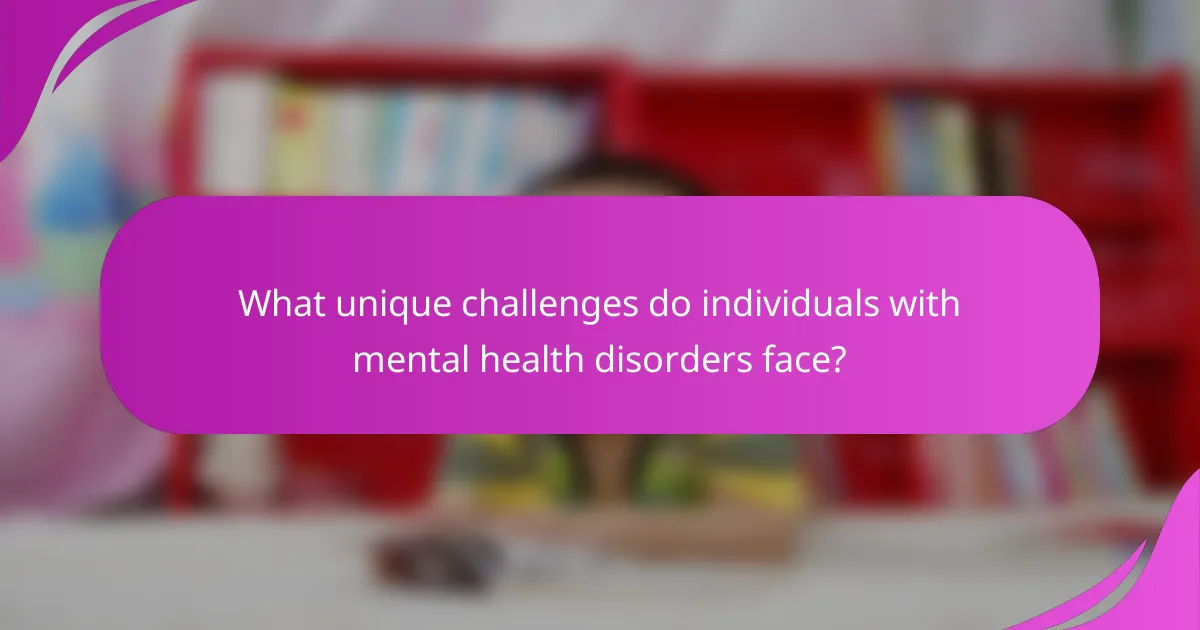
What unique challenges do individuals with mental health disorders face?
Individuals with mental health disorders face unique challenges that significantly impact their daily lives. These challenges include stigma, which often leads to social isolation and discrimination. Many experience difficulties in accessing appropriate treatments, influenced by factors such as cost and availability of mental health services. Furthermore, individuals may struggle with co-occurring physical health issues, which complicate their overall well-being. The lack of understanding and awareness about mental health disorders can exacerbate feelings of shame and hopelessness, hindering recovery efforts.
How does stigma impact treatment seeking?
Stigma significantly hinders treatment seeking for mental health disorders. Individuals often fear judgment or discrimination, leading to avoidance of necessary care. Research indicates that stigma can delay treatment by an average of 10 years, exacerbating symptoms and prolonging suffering. Addressing stigma through education and advocacy is crucial for improving access to mental health services.
What role does socioeconomic status play in mental health?
Socioeconomic status significantly influences mental health, affecting access to resources and support. Individuals from lower socioeconomic backgrounds often face increased stressors, such as financial instability and social isolation, which can exacerbate mental health disorders. Research indicates that lower income levels correlate with higher rates of anxiety and depression. Additionally, limited access to quality healthcare services can hinder effective treatment options, further impacting mental health outcomes. Addressing these disparities is crucial for improving mental health across various socioeconomic groups.
How do cultural perceptions influence mental health disorders?
Cultural perceptions significantly influence mental health disorders by shaping attitudes, stigma, and treatment approaches. Societal views can lead to misunderstanding and discrimination, impacting individuals’ willingness to seek help. For instance, cultures that emphasize strength may discourage open discussions about mental health, increasing isolation. Conversely, supportive cultural attitudes can promote understanding and acceptance, facilitating access to care. Understanding these dynamics is crucial for effective mental health interventions.
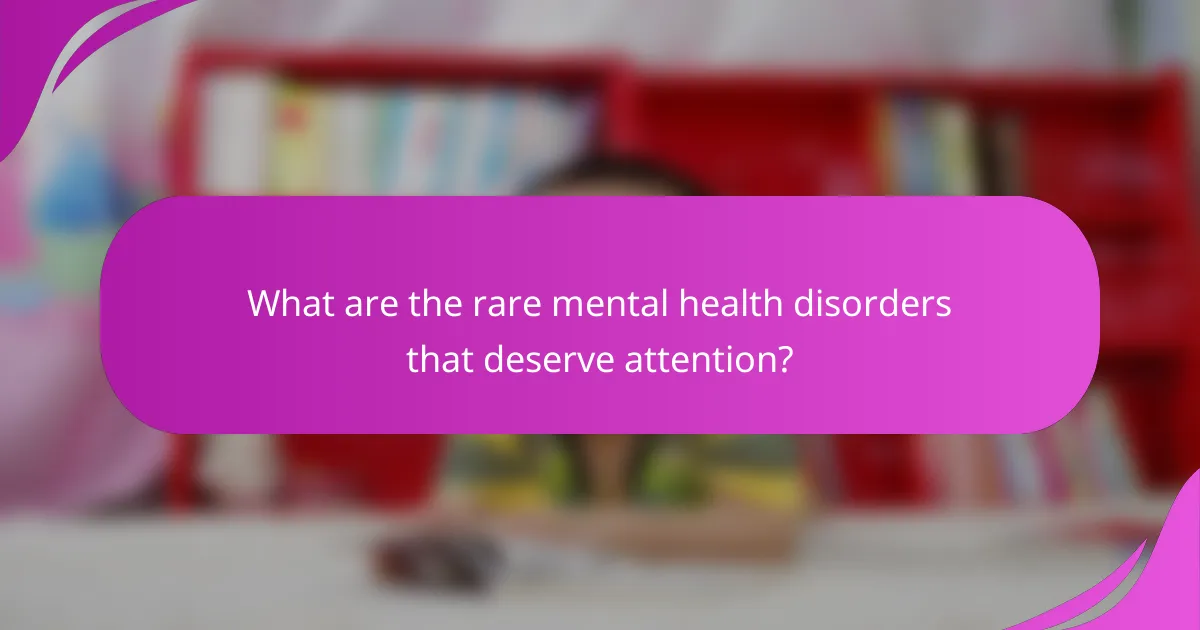
What are the rare mental health disorders that deserve attention?
Rare mental health disorders include conditions such as Cotard’s Delusion, Capgras Syndrome, and Stendhal Syndrome. These disorders often go unnoticed yet significantly impact individuals’ lives. Cotard’s Delusion involves a belief that one is dead or does not exist, while Capgras Syndrome leads to the conviction that loved ones have been replaced by impostors. Stendhal Syndrome triggers intense emotional reactions in response to art. Understanding these disorders is crucial for reducing stigma and improving treatment options.
What is the impact of dissociative disorders?
Dissociative disorders significantly impact mental health by disrupting a person’s sense of self and reality. Symptoms can include memory gaps, identity confusion, and emotional detachment. These effects often lead to difficulties in personal relationships and daily functioning. Treatment typically involves psychotherapy, with a focus on trauma resolution and coping strategies. As a result, early intervention can improve outcomes and reduce stigma associated with these disorders.
How do personality disorders differ from other mental health issues?
Personality disorders are distinct from other mental health issues due to their pervasive and enduring patterns of behavior. Unlike conditions such as anxiety or depression, which can be episodic, personality disorders often manifest as long-term traits that affect how individuals perceive and interact with the world.
These disorders typically emerge in adolescence or early adulthood and can significantly impair social, occupational, and personal functioning. For instance, individuals with borderline personality disorder may experience intense emotions and unstable relationships, contrasting with the more situational nature of anxiety disorders.
Understanding these differences is crucial for effective treatment. While cognitive-behavioral therapy may be effective for anxiety, personality disorders often require more specialized approaches, such as dialectical behavior therapy. This emphasizes the need for tailored interventions based on the unique attributes of each disorder.
Stigma surrounding personality disorders often stems from misconceptions about their nature and treatment. Raising awareness can foster empathy and improve access to appropriate mental health resources.
What are the characteristics of rare mood disorders?
Rare mood disorders exhibit unique characteristics, including atypical symptoms and limited prevalence. These disorders often manifest as severe mood fluctuations, which may not align with common mood disorders like depression or bipolar disorder. Affected individuals may experience profound emotional distress and functional impairment. The rarity of these disorders complicates diagnosis and treatment, leading to potential misinterpretation of symptoms. Understanding these nuances is crucial for effective management and support.
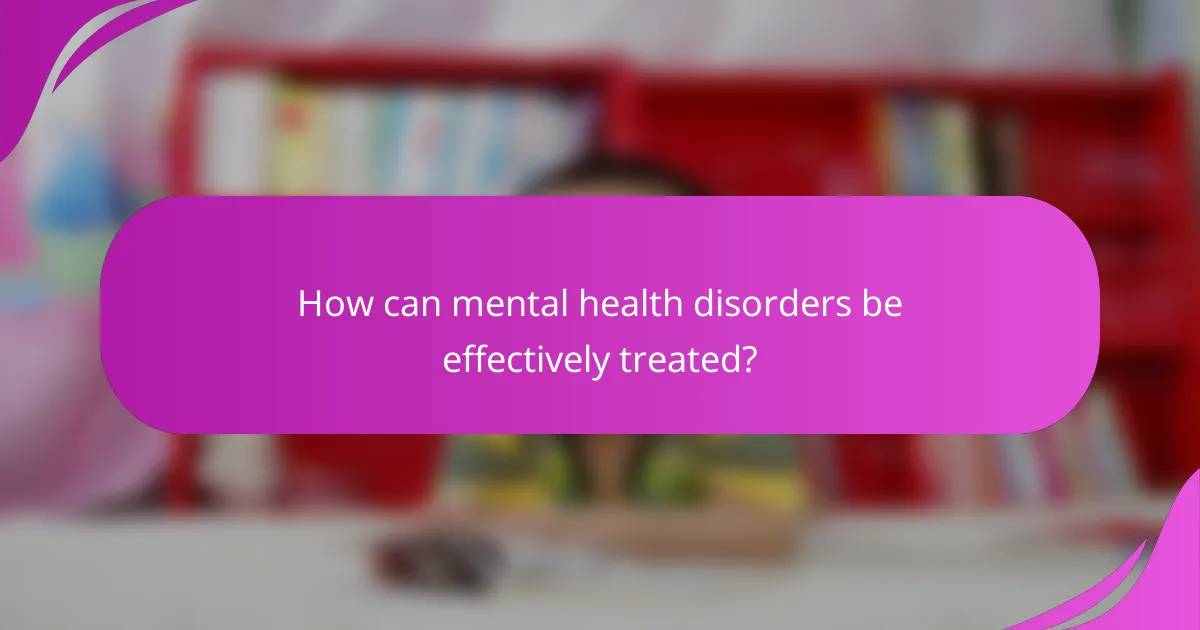
How can mental health disorders be effectively treated?
Effective treatment for mental health disorders includes therapy, medication, and lifestyle changes. Cognitive Behavioral Therapy (CBT) is widely recognized for its effectiveness in addressing anxiety and depression. Medications, such as antidepressants and antipsychotics, can help manage symptoms. Lifestyle changes, including regular exercise, healthy diet, and adequate sleep, also play a crucial role in recovery. Research indicates that a combination of these approaches often yields the best outcomes for individuals. Addressing stigma surrounding mental health is essential to encourage people to seek treatment.
What are the most common therapeutic approaches?
Cognitive Behavioral Therapy, Dialectical Behavior Therapy, Psychodynamic Therapy, Humanistic Therapy, and Acceptance and Commitment Therapy are the most common therapeutic approaches. Each method addresses mental health disorders through unique frameworks. Cognitive Behavioral Therapy focuses on changing negative thought patterns, while Dialectical Behavior Therapy emphasizes emotional regulation and interpersonal effectiveness. Psychodynamic Therapy explores unconscious processes, Humanistic Therapy fosters self-actualization, and Acceptance and Commitment Therapy encourages mindfulness and acceptance of thoughts and feelings. These approaches cater to various needs, enhancing treatment effectiveness for individuals facing mental health challenges.
How do medications play a role in treatment?
Medications play a crucial role in treating mental health disorders by alleviating symptoms and stabilizing mood. They can enhance the effectiveness of therapy and improve overall quality of life. Antidepressants, antipsychotics, and mood stabilizers are common types of medications used in treatment. Each type targets specific symptoms, such as anxiety, depression, or psychosis. For example, selective serotonin reuptake inhibitors (SSRIs) are frequently prescribed for depression, demonstrating a unique attribute of efficacy in symptom management. As a result, medications can be a vital component of a comprehensive treatment plan.
What alternative therapies are gaining popularity?
Holistic therapies are gaining popularity as alternative treatments for mental health disorders. These approaches include practices like mindfulness, yoga, and art therapy, which emphasize emotional well-being and personal growth. Research indicates that mindfulness can reduce anxiety and depression symptoms, while art therapy fosters self-expression and healing. Many individuals are seeking these therapies to complement traditional treatments, aiming for a more integrated approach to mental health.
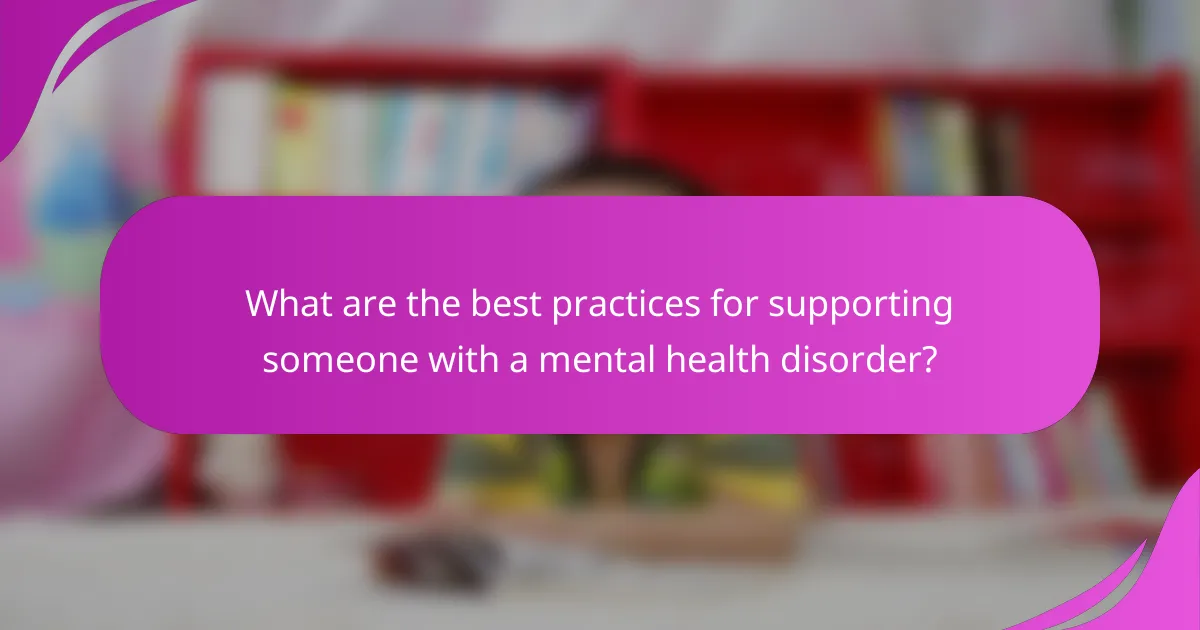
What are the best practices for supporting someone with a mental health disorder?
Supporting someone with a mental health disorder involves empathy, active listening, and encouragement. Establish a safe space for open communication, validate their feelings, and avoid judgment. Encourage professional help and be patient, as recovery takes time. Offer practical support, like helping with daily tasks, and educate yourself about their condition to better understand their experience.
How can family and friends provide effective support?
Family and friends can provide effective support by fostering open communication, offering emotional reassurance, and encouraging professional help. Active listening helps individuals feel understood and valued. Providing practical assistance, like accompanying them to appointments, can also ease their burden. Maintaining a non-judgmental attitude is crucial in reducing stigma and promoting trust.
What resources are available for ongoing education?
Various resources are available for ongoing education about mental health disorders. Online courses, webinars, and workshops provide valuable insights into symptoms, treatments, and stigma.
Professional organizations like the National Alliance on Mental Illness (NAMI) and Mental Health America offer educational materials and community events. Additionally, academic institutions frequently publish research and host conferences that focus on the latest findings in mental health.
Support groups and peer-led initiatives also serve as platforms for sharing experiences and knowledge. Engaging with these resources enhances understanding and promotes awareness of mental health issues.
How can individuals advocate for themselves in treatment?
Individuals can advocate for themselves in treatment by clearly communicating their needs and preferences. Assertiveness is key; express concerns about symptoms and treatment options. Researching mental health disorders empowers individuals to engage in informed discussions with healthcare providers. Setting specific goals for treatment enhances collaboration. Building a support network fosters encouragement and accountability. Documenting experiences and progress aids in conveying the effectiveness of treatment.
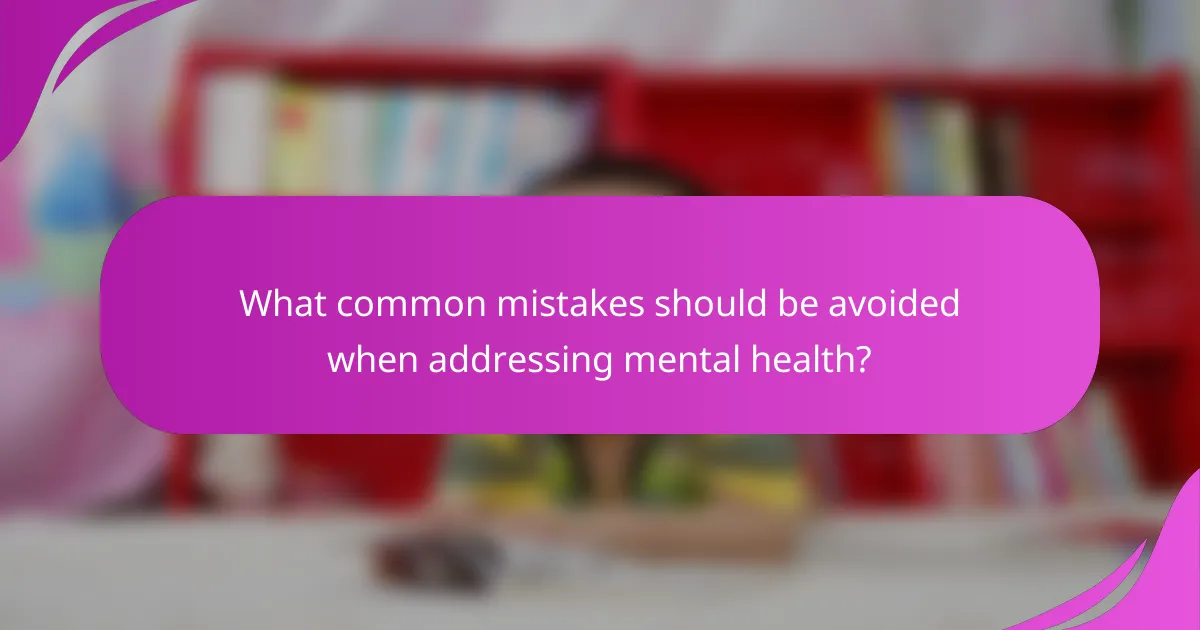
What common mistakes should be avoided when addressing mental health?
To effectively address mental health, avoid common mistakes such as stigmatizing language, oversimplifying symptoms, and neglecting professional help. Misunderstanding mental health can lead to harmful assumptions and inadequate support. Recognizing the complexity of disorders is essential for proper treatment and empathy.
How can misconceptions about mental health be corrected?
Misconceptions about mental health can be corrected through education, open conversations, and personal stories. Increasing awareness about symptoms and treatments helps dismantle stigma. For example, sharing accurate information about anxiety disorders can clarify common misunderstandings. Engaging with mental health professionals also fosters a better understanding of these conditions.
What steps can be taken to reduce stigma in society?
To reduce stigma in society, education and awareness are crucial. Implementing community programs that focus on mental health can foster understanding and empathy. Encouraging open conversations about mental health challenges can dismantle misconceptions. Promoting stories of recovery highlights the potential for positive outcomes. Supporting policies that protect individuals with mental health disorders can further normalize these discussions.
How can individuals prioritize their mental health effectively?
Prioritizing mental health involves consistent self-care practices, seeking professional help, and fostering supportive relationships. Individuals should establish routines that include physical activity, mindfulness, and adequate sleep. Engaging in therapy or counseling can address underlying issues and provide coping strategies. Additionally, surrounding oneself with positive influences enhances emotional resilience.
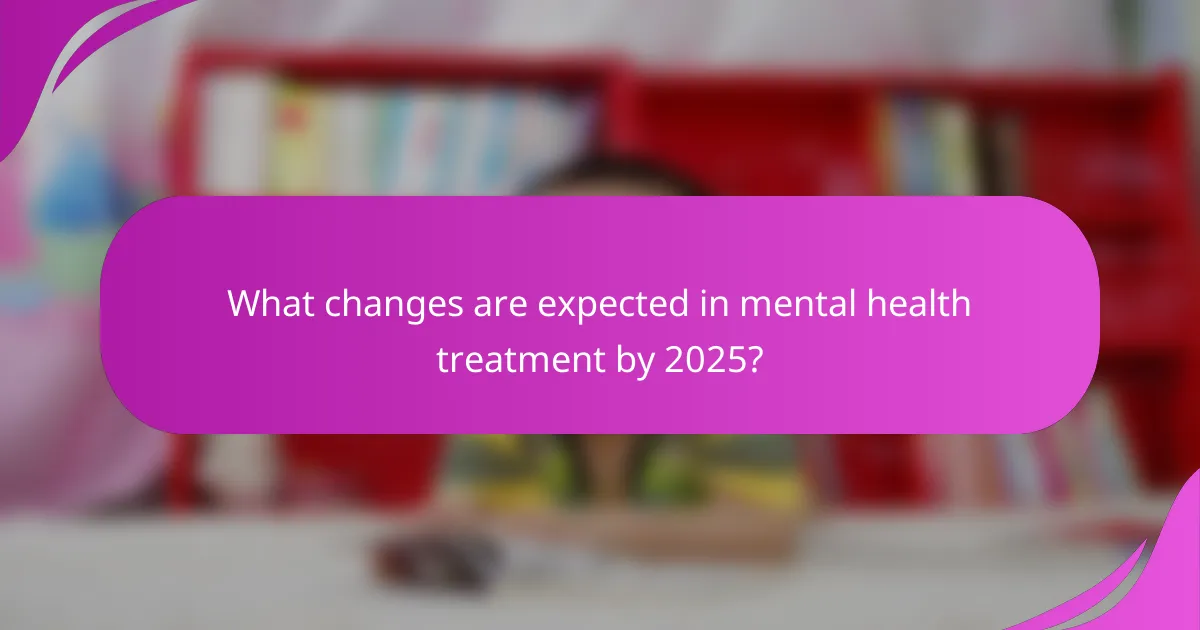
What changes are expected in mental health treatment by 2025?
By 2025, mental health treatment is expected to become more personalized, integrating technology and holistic approaches. Advances in teletherapy and AI-driven diagnostics will enhance accessibility and accuracy. A focus on prevention and community-based support will reduce stigma and improve outcomes. Additionally, the incorporation of genetic and biomarker insights will tailor treatments to individual needs, shifting away from one-size-fits-all methods.
How might technology influence mental health care?
Technology significantly enhances mental health care by improving access, diagnosis, and treatment options. Telehealth platforms allow remote consultations, reducing barriers for patients. Digital tools like apps and online therapy provide personalized support, promoting engagement and adherence. Wearable devices monitor mental health metrics, offering real-time insights. As a result, technology fosters a more proactive approach to mental health management.
What emerging trends are shaping mental health awareness?
Increased mental health awareness is driven by social media, teletherapy, and workplace initiatives. Social media campaigns destigmatize disorders, fostering open conversations. Teletherapy expands access, allowing individuals to seek help conveniently. Workplace wellness programs prioritize mental health, integrating support into corporate culture. These trends collectively enhance understanding and reduce stigma surrounding mental health disorders.
What role will community support play in future treatment models?
Community support will be essential in future treatment models for mental health disorders. It fosters connection, reduces stigma, and enhances recovery outcomes. Research shows that individuals with strong community ties experience lower levels of anxiety and depression. Integrating community resources into treatment plans can provide holistic support, addressing both psychological and social needs. Collaborative approaches that involve family, friends, and local organizations can lead to more sustainable mental health solutions.
